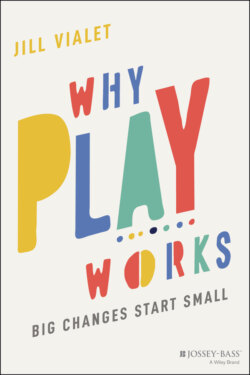Читать книгу Why Play Works - Jill Vialet - Страница 19
Notes
Оглавление1 1 Suits, Bernard. The Grasshopper: Games, Life and Utopia. Broadview Press, 2005 (first published 1978), 41.
2 2 Sutton‐Smith, Brian. The Ambiguity of Play. Harvard University Press, 2001, 198.
3 3 Huizinga, Johan. Homo Ludens. Random House, 1938, 13.
4 4 Montessori, Maria. Child's Instinct to Work. AMI Communications, 1973.
5 5 Parten, Mildred B. “Social Participation among Pre‐School Children.” The Journal of Abnormal and Social Psychology 27 (1932): 243–269.
6 6 Brown, Stuart. Play: How It Shapes the Brain, Opens the Imagination, and Invigorates the Soul. Penguin Group, 2009.
7 7 “Discovering the Importance of Play through Personal Histories and Brain Images An Interview with Stuart L. Brown.” American Journal of Play 1, 4 (2009): 399–412.
8 8 Evans, John, and Anthony Pellegrini. “Surplus Energy Theory: An Enduring but Inadequate Justification for School Break‐Time.” Educational Review 49, 3 (1997): 229–236.
9 9 McLeod, S. A. “Jean Piaget's Theory of Cognitive Development: Background and Key Concepts of Piaget's Theory.” Simply Psychology (June 6, 2018).
10 10 Sutton‐Smith, Brian. The Ambiguity of Play. Harvard University Press, 2001.
11 11 Gray, P. Free to Learn: Why Unleashing the Instinct to Play Will Make Our Children Happier, More Self‐Reliant, and Better Students for Life. Basic Books/Hachette Book Group, 2013.
12 12 London, Rebecca. Rethinking Recess: Creating Safe and Inclusive Playtime for All Children in School. Harvard Education Press, 2019, 66.
13 13 Claire Liu, S. Lynneth Solis, Hanne Jensen, Emily Hopkins, Dave Neale, Jennifer Zosh, Kathy Hirsh‐Pasek, and David Whitebread. Neuroscience and Learning through Play: A Review of the Evidence. The Lego Foundation, November 2017.
14 14 Alison Gopnik, “AIs Versus Four‐Year‐Olds: Looking at What Children Do May Give Programmers Useful Hints About Directions for Computer Learning,” in John Brockman (ed.), Possible Minds. Penguin, 2019.
